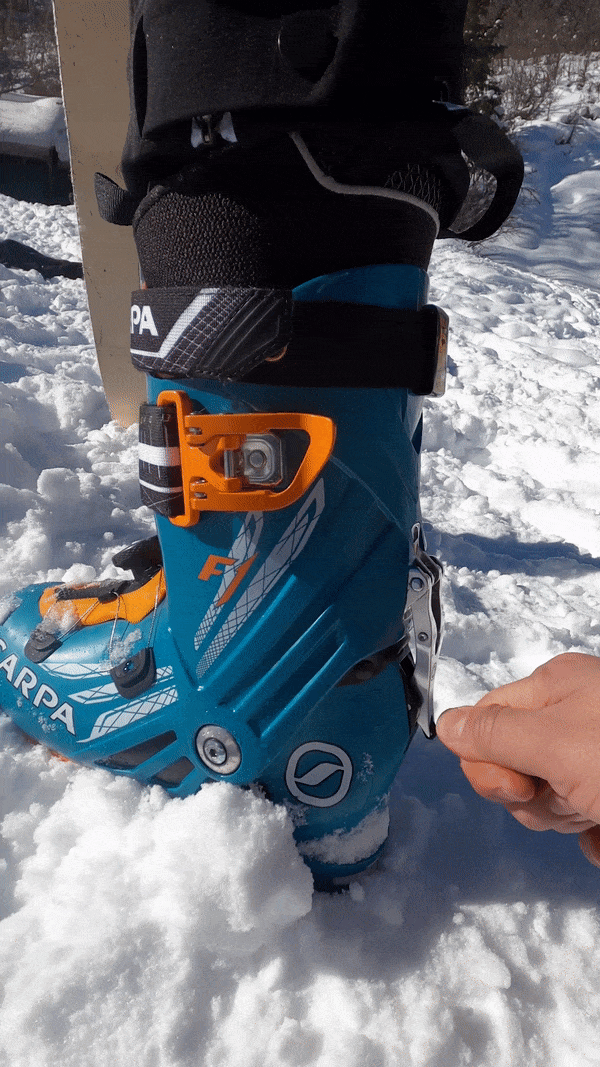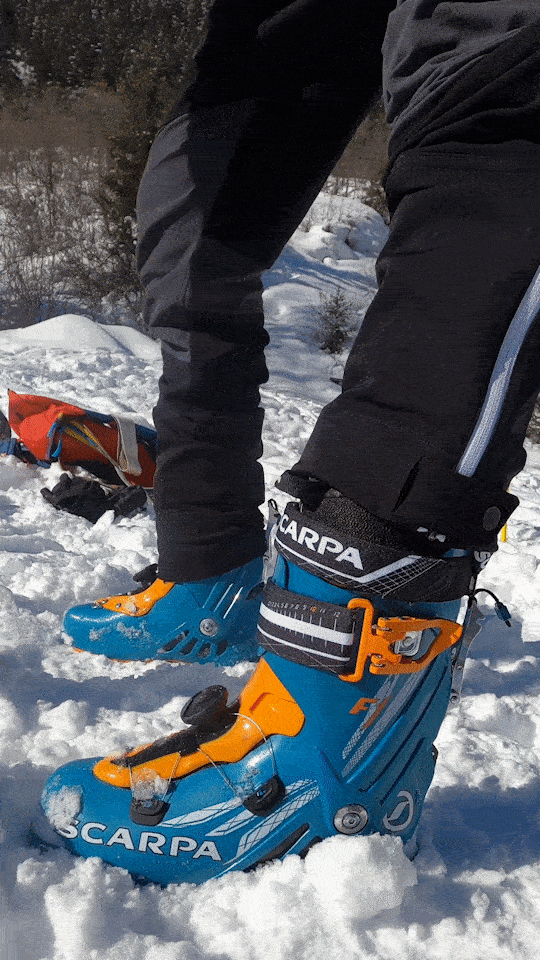Here at the Ute Mountaineer, we like to ski uphill #weskiuphill. We know it sounds a little funny to those who are unfamiliar with the concept. Heck it even looks a little funny at first, but hear us out. We’ve been doing this whole uphill skiing thing for 40+ years and absolutely love introducing others to the sport. So if you’re interested in learning a bit more or trying it yourself, then you’ve come to the right place!
Like any good outdoor activity, you may hear several names that for the most part are referring to the same thing. Uphill skiing, uphilling, skinning, touring, alpine touring, AT, skimo, randonee, whatever you want to call it - we are talking about the activity of human powered uphill movement on skis.
How It Works
In a nutshell, a climbing skin is attached to the bottom of the ski that glides when moving forward, but grips when pulled backwards. Imagine an angled carpet that is smooth in one direction and grippy in the other direction. Combine that climbing skin with some specialized boots and bindings that let your heel rise on the uphill then lock in for the downhill and you’re uphill skiing!
Why You Should Try It
Here are just a few reasons why we ski uphill:
Exercise - Uphill skiing is like the best day you’ve ever had on a StairMaster...but with infinitely better views, fresh mountain air, you actually go somewhere, and when you reach the top you get to click in to start skiing down! It’s a the whole body workout, taking care of all your cardio and fitness needs. Lift access skiing will always be a blast, but when you’re sitting on your bum for the uphill you won’t find quite the same satisfying sculpting burn that uphill skiing provides.
Experience - Uphill skiing adds a completely new perspective to your time on the mountain. The slower pace on the uphill allows you to take in your surroundings and notice new details that you may have missed on the lift. The phrase “earn your turns” is often heard in the uphill world and for good reason. After all the work you put in to get up you really savor each turn headed down.
Exploration - When you aren’t reliant on chair lifts to get you around the mountain, your winter wonderland playground rapidly expands. In this blog post we are focused on uphill skiing within the patrolled ski areas of Aspen / Snowmass, but we will lightly touch on the subject of backcountry touring and skiing.
Social - Uphill skiing is a great solo or group activity! Further into this post we share some of the best uphill events and gatherings in the Aspen area.
**Skiing or traveling outside of the ski area can lead to very serious and real dangers. It is absolutely necessary to have the proper education, experience, and equipment before doing any form of backcountry skiing.**
Where to Uphill Ski
We are fortunate to be in a community and area where uphill skiing is incredibly popular and supported. The Aspen Skiing Company is considered to be one of the most progressive and supportive ski resorts in North America when it comes to uphill skiing. All four Aspen / Snowmass ski areas have dedicated uphill routes and three of the mountains (Aspen Highlands, Buttermilk, and Snowmass) allow for uphill travel during the day.
We like to recommend the Tiehack route on Buttermilk or the Village Express Route on Snowmass to beginners. Look for the orange signs marking the uphill route.
Base of the Tiehack Express Lift and beginning of the Tiehack Uphill Route
Many ski resorts charge users for uphill skiing or don’t allow it at all. In order for Aspen Skiing Company to continue their pro-uphill approach it’s imperative that uphillers comply with the safety policies.
*2020 UPDATE - The Aspen Skiing Company has implemented new uphill policies to address challenges related to COVID-19. Please read these new policies below and visit SkiCo’s Uphill Policies Page for more information.*
Uphillers will need to remain on designated, signed routes during all operating hours.
No uphilling will be allowed during Holiday blackout periods. December 26, 2020 - January 2, 2021. February 13 & 14.
Closures on the designated routes are possible during heavy use times to address capacity challenges and safety concerns.
During operating hours, the designated uphilling routes will be treated much like a ski trail with an open or closed sign signaling if access is available at that time.
All uphillers should check the Aspen Snowmass App before heading out to see if their selected route is open.
Please review the Uphilling Policies for each mountain before heading out:
The Gear
Now we get to a gear shop’s favorite part, the gear! Uphill ski equipment has a tough job. It’s trying to be light, mobile, and efficient on the uphills - while still being stable, powerful, and consistent on the downhills. Let’s dive into the basics of how it works.
The Boots
Uphill Ski boots focus on being lightweight, having a large range of motion when in ‘walk’ mode, and still providing downhill performance when in ‘ski’ mode. When you pick up a pair of uphill boots you’ll notice a serious weight difference from most alpine or downhill boots. The Ski/Walk mechanism in uphill boots allows for both forward and backwards movement. This makes a significant improvement over alpine boots for movements like gliding, stepping, and hiking commonly found in uphill skiing.
Uphill boots also have special ‘tech pin’ fittings for use in uphill ski bindings, but more on that below.
The Bindings
Uphill ski bindings aim to provide low weights, efficient ‘free-heel’ motion, and simplicity on the uphill. Then turn around to have powerful energy transfer and consistent release characteristics on the downhill. The tech pin design, first released by Dynafit in the 1980’s, remains the most popular for its ultra efficient toe pivot motion.
The Skis
At first glance uphill specific skis might look the same as their downhill siblings, but there are differences that better suit them for scooting up the hill. Specialized materials, construction, and design lead to skis that are usually significantly lighter than the downhill equivalent. Other subtle features like rubber tip or tail clip sections for climbing skins make life easier for those earning their turns.
The Climbing Skins
The secret sauce to going uphill on skis. Humans have been attaching animal skins to the bottom of skis to travel over snow for centuries. The concept is a fairly simple one, create an attachment that has glue to stick to the ski on one side and then an angled skin that glides in one direction and grips in the opposite direction on the other side.
Glide then grip.
Modern skins are comprised of two types of materials:
Mohair, a fabric from the hair of goats offers superior glide, lightweight, and packability
Nylon, a synthetic fiber offers better grip and durability.
Hybrid, a blend of mohair and nylon for the best of both worlds. This is our shop favorite.
*Pro Tip* To protect the longevity of your skins always use a ‘cheat sheet’ or some form of barrier to keep the glue from sticking to itself. Otherwise, consistently unsticking the glue side of the skin from itself will degrade the glue and shorten the life of the skin. Also, climbing skins use a cold temperature glue so make sure to store your skins in a cool and dry place.
Now that you know what you need to get started come by the store and we can show you what everything looks like in person. We take pride in having the best uphill equipment available for sale and demo. Our demo fleet covers all types of uphill skis, boots, and bindings from ultralight racing to big mountain setups. We offer a Try Before You Buy option where you can apply the cost of Two Demo Days towards purchase!
Other Essentials - There is some other essential gear you’ll want to have with you for a good day of uphilling.
Proper clothing! Uphill and then downhill skiing will expose you to the full gamut of body and outdoor temperatures. We could write an entire novel on technical apparel as we are believers that quality clothing is gear, but we’ll save that for another time. To cover the basics you’ll want a quick drying base layer, insulating mid layer, and a weather / waterproof outer layer.
A small backpack to hold your other goodies
A water bottle (you will be sweating). We usually recommend an insulated thermos for colder days as even the insulated camelbak tubes tend to freeze.
Snacks for energy and because they are delicious.
Sunglasses and or goggles.
Gloves, ideally lightweight for the uphill and then a heavier pair for the downhill.
A headlamp for early morning or evening adventures.
Uphill skiing can be even more fun when you bring a friend. Our community has some unique uphill focused events and gatherings.
The Aspen SkiMo & Uphill Facebook Page is a great place to keep current on all things Uphill Skiing in the Aspen area.
Uphill Socials
What began as a handful of friends heading up the mountain before work, has grown into 100+ uphillers making their way to the top of Buttermilk Mountain every Friday Morning to share smiles and some delicious breakfast. The Uphill Socials start just after the New Year and run through the end of the ski season.
Check out our $250 4 Day Rental Punch Pass for the Uphill Socials.
Full Moon Dinner
Also taking place on top of Buttermilk at the Cliffhouse are the Full Moon Dinners. Aspen Skiing Company will open the restaurant at night during each Full Moon throughout the Winter. Hike up and grab some hot chocolate and dinner! More information and schedule here.
NEXT STEPS
Snow Safety
Backcountry skiing is often the next interest for those who are uphill skiing in the ski area and looking for more terrain. However, to safely leave the ski area and enter the unpatrolled and unmanaged backcountry requires a new level of knowledge, experience, and education. The best way to acquire that experience is with a professional guiding / education service. In the Aspen area we recommend:
Hut Trips
Colorado has a long history of building huts in the backcountry for visitors to ski to and enjoy overnight stays in the wilderness. Named after the storied World War II military division, the 10th Mountain Division Hut Association manages over 30 huts in Colorado and are the area experts on hut trips. These ‘huts’ are far from primitive shelters, they offer comfortable protection from the elements and beautiful scenery. Most huts require skiing along routes with potential avalanche hazards. As the Hut Division says, “We strongly suggest that someone in every group be experienced in evaluating avalanche and snow stability hazards and practicing prudent backcountry and winter mountain travel techniques.”
Racing
Uphill skiing has a competitive side known as SkiMo, short for ‘ski mountaineering’. Skimo takes everything you know of uphill skiing and cranks up a notch. Racers will experience plenty of uphilling, hiking, and high speed downhills during a skimo race. When every ounce counts you can bet that the gear gets lighter and the clothes get tighter. Aspen has a strong and competitive skimo community, hosting two of the US’s premiere races the Grand Traverse and Power of Four.
We hope this guide has been helpful and piqued your interest for the wonderful world of uphill skiing. Questions? Comments? Good stories? Leave a comment below, give us a call, shoot an email, or drop by the store to chat!
Tag us on social and show us your uphill skiing adventures!















